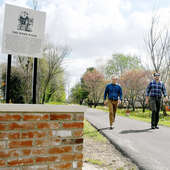How community leaders attract your favorite brands to town

Brian Gerau said he is keenly aware of the stores people would like to see located in the city of Jackson and the rest of Cape Girardeau County. The process of getting these stores, however, is much more complicated.
“We talk about businesses like Trader Joe’s, Whole Foods, Home Depot or whatever it may be that we don’t have here,” said Gerau, executive director of Jackson Area Chamber of Commerce since 2008.
“The biggest challenge is when people say, ‘Hey, you need to get this in here.’ Folks need to ask first whether the desired business is a franchise or corporate-owned. If it’s a franchise, you need an investor or investors, plural. If you want to look at a fast-food franchise, for example, the [prospective] franchise owner has to be $1 million liquid. Sometimes people just want us to snap our fingers and get a Red Robin [restaurant] or whatever,” Gerau said.
James Stapleton, chairman of SE MO Redi (Southeast Missouri Regional Economic Development) and co-founder of Cape Girardeau’s Codefi, agreed such undertakings are “expensive” and “higher risk than they’ve been in the past,” adding his thoughts about today’s ability to do virtual shopping.
“For a long time, I feel like you could kind of measure and predict what retail was going to do. A lot of it was data driven. You asked questions such as ‘Are there enough people?’ ‘Is there enough spending?’ ‘Is there enough nearness to other brands to make sense?’ But with the online component becoming such a big part of people’s options now, there’s been a lot of disruption lately in the retail sector. Retail, I think, is much more of a high-risk proposition [now]. Add to that the expense and the uncertainty about how the latest set of trends all shakes out in retail,” Stapleton said.
In a July 6, 2020, Harvard Business Review article, “Rewriting the Rules of Retail,” writer Denise Lee Yohn said thanks to the aftermath of the coronavirus pandemic, the retail landscape has changed.
Note the following HBR excerpt.
“Retailers need to stop expecting business to return to ‘normal.’ There’s no going back to how it was anytime soon. Even before the COVID-19 pandemic and economic crisis, brick-and-mortar retailers had been fighting a fierce battle against Amazon and other e-commerce players. Those challenges have now accelerated at staggering speed,” Yohn wrote.
“The latest data from McKinsey shows consumers are likely to keep the behaviors they’ve adopted amid stay-at-home orders, such as more online shopping and fewer mall visits. Retailers can’t afford to be in a wait-and-see mode. First, they need to reimagine their baseline requirements and then turn their attention to taking their customer experience to the next level.”
CONSUMER ‘WANTS’
This Facebook poll conducted in January 2023 by B Magazine yielded the following unscientific results from about 460 respondents who identified more than 40 specific retailers they would like to see in Cape Girardeau and the rest of the county.
The top 10
1. 30.8%: Trader Joe’s
2. 10.2%: Ulta Beauty
3. 10%: HomeGoods
4. 3.7%: Dillard’s
5. 3.3%: Michaels
6. 3%: Marshalls
7. 2.8%: Ross Dress for Less
8. 2.6%: Kroger
9. 2.4%: JOANN Fabrics
10. (tie) 2.1% Nordstrom
2.1% Costco
2.1% Kirkland’s
Others in descending order of mentions (25% total): Whole Foods; HyVee; World Market; Bed Bath & Beyond; Crumbl Cookies; Big Lots; Bass Pro Shops; Publix; Fresh Thyme; Chipotle; Meijer; DSW; Whataburger; Buc-ees; H&M; Ikea; Torrid; Home Depot; Loft; Dick’s Sporting Goods; Nordstrom Rack; Incredible Pizza; Melting Pot; FooSackly’s; QuikTrip; In-N-Out Burger; Portillo’s; Express; Container Store; Total Wine; Dewey’s Pizza; Coldstone Creamery; Raising Cane’s Chicken Fingers; Sprouts; Crate & Barrel.
COMPETING FOR BRANDS
Tom Kelsey, of Cape Girardeau’s Lorimont Commercial Real Estate, said people must remember most of the national companies they would like to see have outsourced their real estate services.
“In the old days, [brands] had their own in-house people. Some still do, but a lot of the work has been farmed out,” Kelsey said.

“What [brands] do is put the word out that, for example, they’re interested in this market or that market. The broker, then, reaches out usually to a [local] broker and gets as much information as possible to feed back to the interested company. In the old days, frankly, we did a lot of cold calling. We’d say to that company, or that brand, ‘We think we need you in our community.’ A lot of that activity led to dead ends,” Kelsey said. “It’s not that we still don’t reach out to companies to a certain extent. … If we see somebody came to Sikeston or to Poplar Bluff, that would be a trigger for us to say, ‘Hey, if you’re going to Bluff or to Sikeston or somewhere else, you need to be in the Cape market too.’ We find out the brokerage representing that brand and try to network to see if we can’t show them the advantages of being here.”
“A lot of times, we’ll hear, ‘We’re sorry, we did that deal down there [in Sikeston or Poplar Bluff] but Cape’s not on our radar right now.’ For instance, Home Depot has looked at this market several times. Over a period of years, it’s been a different broker for them,” Kelsey said.
Kelsey said brokers may reach out looking for specific acreage and send what their parameters are to see if anything is available. He said what brokers working for specific brands usually need are site plans, a marketing brochure and economic data for the Cape Girardeau area, which Kelsey said they “are very proud of.”
Kelsey said when brands used to have in-house marketing and brokerage folks, he would try to pinpoint specific brands and companies to come to Cape.
“I remember one guy said, ‘We got your beautiful presentation, but when I come back off the road, I’ll have a stack of these waiting for me. A lot of times I’ll just pick them up and throw them in the can because I’m only working on what my client tells me to do at that moment,’” Kelsey said.
Adrienne Henry, manager of real estate leasing and development for Drury Southwest, said her process is pretty straightforward for trying to attract a national brand to Southeast Missouri.
“It’s a long process, typically, and usually starts with cold calls. We identify companies we want to work with in the market, as well as properties or land we have that we feel would be a good fit to attract them. We start calling constantly trying to make a connection,” Henry said.

Henry said Drury Southwest will also attend a lot of real estate conferences, such as the annual International Council of Shopping Centers (ICSC) event in Las Vegas, which is a larger real estate network.
“We go and tell attendees why they should come to Cape and what Drury Southwest can do for them in terms of property management and construction capability. We also try to educate them on Cape as a market,” Henry said.
CHALLENGES
The professionals interviewed for this piece all note how important certain data points are to national brands.
“A lot of companies look at population before they’re interested in learning about the community. On the face of it, our population may be under whatever target number they want before going into a market. However, if you go beyond the static Census figures for a city or a county, you’ll see our population swells to 100,000, plus or minus, because of the people who come here on a daily basis to work, to shop or to go to the university. They come here for medical, for retail, for lots of different reasons. We stress we’re a regional hub and the traffic counts support that thesis. It’s not simply the residential population figures that matter,” Henry said.
Rob Gilligan, president & CEO of Cape Girardeau Area Chamber of Commerce since April 2022, suggested it’s important to interpret the data accurately.
“We’ve got 40,000 people living in the city of Cape Girardeau. Add to that figure the fast-growing Jackson community. We’ve got anywhere from 80,000 to 100,000 in our metropolitan statistical area (MSA). When you’re putting together an effort to recruit, we need to work with our messaging,” Gilligan said.
The Cape Girardeau MSA is comprised of Cape Girardeau and Bollinger counties in Missouri and Alexander County in Illinois with a July 1, 2021, total population estimate of 97,699, according to the most recently available data.
“Your no. 1 anchor is Walmart and everybody wants to be right beside that brand because they’re the top driver of traffic. Places like Menards, Lowe’s, Target, Best Buy — all of which we already have in our community — can also help us recruit secondary and tertiary retailers. We should be looking to identify and fill gaps we see in our area,” Gilligan added.
Kelsey said there are growth areas today in retail, with the biggest two successes being specialty stores and discounters.
“The greatest discounter in the world is Costco. We’d love to have that store here. I don’t know if Costco would come into our market because of our size [and] because we’ve already got a Sam’s Club. If Costco would consider us, the old Sears building on Siemers Drive in Cape would be a perfect fit because of its immense size and its location. The challenge is to convince a retailer that we are truly regional here in Cape. If you’re only looking at the population of Cape Girardeau, you’re missing a huge part of the picture. Just stand out on William Street, on Route K, some morning, and [you’ll] see the inflow of cars coming from outside our region. That’s what it was like for us, years ago, when Red Lobster was recruited. That restaurant doesn’t have to depend, therefore, just on the population base of the city of Cape. The message is we are a true regional hub, the largest city between St. Louis and Memphis.”
Henry agrees with her commercial real estate colleague on Cape Girardeau serving as a hub for Southeast Missouri.
“Educating people on the regional hub status is vital because a lot of companies look purely at population. You need a population of 75,000 before some retailers are interested in coming here. Our daily population, Monday through Friday, is nearly 100,000. Getting this information out is the biggest challenge I run into,” she said.
Gerau’s Jackson chamber, along with the city of Jackson, invests in paying a full-time retail and membership director staff position.
“This person can be dedicated to reach out to whatever industry we’re trying to get here. My biggest goal is to try and recruit something we don’t already have. Again, if we’re talking about a restaurant franchise, we need investors and an owner who meets franchise requirements. This can be a bit of a challenge, not impossible, and often kind of exciting,” he said.
































Respond to this story
Posting a comment requires a subscription.